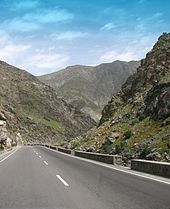Highway 1 (Afghanistan)
| Highway 1 | |
|---|---|
| Highway system | |
| Highways in Afghanistan |

Kabul–Kandahar Highway Highway around Wardak Province in 2010

Somewhere on the Kabul–Jalalabad Road
Highway 1 or A01, formally called the Ring Road (Pashto: د افغانستان حلقوي سړک; Dari: شاهراه حلقوی افغانستان), is an ancient 2,200 kilometres (1,400 mi) two-lane road network circulating inside Afghanistan, connecting the following major cities (clockwise): Kabul, Maidan Shar, Ghazni, Kandahar, Delaram, Herat, Maymana, Sheberghan, Mazari Sharif, and Puli Khumri. Originally built and renovated by the Mauryan Empire, it was a part of the Grand Trunk Road project and well documented by Greek and Buddhist sources in the 4th century BCE. It was renovated many times, by Sher Shah Suri, Mughal Empire and the British Empire. It has extensions that also connect Jalalabad, Bamyan, Khost, Lashkargah, Zaranj (Route 606), Farah, Islam Qala, Torghundi, and Kunduz. It is part of AH1, the longest route of the Asian Highway Network.
Part of Highway 1 has been refurbished since late 2003, particularly the Kabul–Kandahar Highway, with funds provided by the United States, Saudi Arabia and others. Most work on that stretch was done by Turkish, Indian and local companies. Japanese companies were also involved near the southern Afghan province of Kandahar. In the west, Iran participated in the two-lane road construction between Islam Qala and the western Afghan city of Herat. Pakistan rebuilt the Jalalabad–Kabul Road.
Contents
1 Kabul - Kandahar
2 Kandahar - Herat
3 Kabul - Jalalabad
4 See also
5 Notes
Kabul - Kandahar
The Kabul–Kandahar Highway is a 483-kilometer (300 mi) road linking Afghanistan's two largest cities, Kabul and Kandahar. This highway is a key portion of the Ring Road. Approximately 35 percent of Afghanistan's population lives within 50 km (31 mi) of the Kabul to Kandahar portion of the Ring Road.
The Kabul-Kandahar highway underwent major repairs carried out by the United States and Japanese governments with assistance in planning and design by Turkish and Indian engineers. Phase one of paving was completed in December 2003 and the highway was opened to traffic.[1] However, the road has badly deteriorated since that time, from heavy trucks and also from terrorist sabotage. Furthermore, armed guards must protect highway repair crews from ambushes. Banditry and extortion at Taliban checkpoints continue to be problems.[2]
Kandahar - Herat
Kabul - Jalalabad
The A01 national highway, Jalalabad - Kabul, follows the Tang-e Gharu gorge, parallel to the Kabul River, for 64 kilometres (40 mi). The two-lane Kabul Gorge highway runs along 600 metres (2,000 ft) cliffs. Fatal traffic accidents occur in this area, mainly due to reckless driving.[3]
See also
- Transport in Afghanistan
Notes
| Wikimedia Commons has media related to Highway 1 (Afghanistan). |
^ USAID Press Release: Afghans Celebrate Phase I Completion of Kabul to Kandahar Highway Archived 2011-10-20 at the Wayback Machine
^ Goldstein, Joseph; Muzhary, Fazal (24 March 2015). "Attack by Gunmen on Afghan Highway Unnerves Travelers". New York Times. Retrieved 23 October 2016..mw-parser-output cite.citationfont-style:inherit.mw-parser-output .citation qquotes:"""""""'""'".mw-parser-output .citation .cs1-lock-free abackground:url("//upload.wikimedia.org/wikipedia/commons/thumb/6/65/Lock-green.svg/9px-Lock-green.svg.png")no-repeat;background-position:right .1em center.mw-parser-output .citation .cs1-lock-limited a,.mw-parser-output .citation .cs1-lock-registration abackground:url("//upload.wikimedia.org/wikipedia/commons/thumb/d/d6/Lock-gray-alt-2.svg/9px-Lock-gray-alt-2.svg.png")no-repeat;background-position:right .1em center.mw-parser-output .citation .cs1-lock-subscription abackground:url("//upload.wikimedia.org/wikipedia/commons/thumb/a/aa/Lock-red-alt-2.svg/9px-Lock-red-alt-2.svg.png")no-repeat;background-position:right .1em center.mw-parser-output .cs1-subscription,.mw-parser-output .cs1-registrationcolor:#555.mw-parser-output .cs1-subscription span,.mw-parser-output .cs1-registration spanborder-bottom:1px dotted;cursor:help.mw-parser-output .cs1-ws-icon abackground:url("//upload.wikimedia.org/wikipedia/commons/thumb/4/4c/Wikisource-logo.svg/12px-Wikisource-logo.svg.png")no-repeat;background-position:right .1em center.mw-parser-output code.cs1-codecolor:inherit;background:inherit;border:inherit;padding:inherit.mw-parser-output .cs1-hidden-errordisplay:none;font-size:100%.mw-parser-output .cs1-visible-errorfont-size:100%.mw-parser-output .cs1-maintdisplay:none;color:#33aa33;margin-left:0.3em.mw-parser-output .cs1-subscription,.mw-parser-output .cs1-registration,.mw-parser-output .cs1-formatfont-size:95%.mw-parser-output .cs1-kern-left,.mw-parser-output .cs1-kern-wl-leftpadding-left:0.2em.mw-parser-output .cs1-kern-right,.mw-parser-output .cs1-kern-wl-rightpadding-right:0.2em
^ Dexter Filkins, "Sarobi Journal: On Afghan Road, Scenes of Beauty and Death", The New York Times (February 7, 2010)
